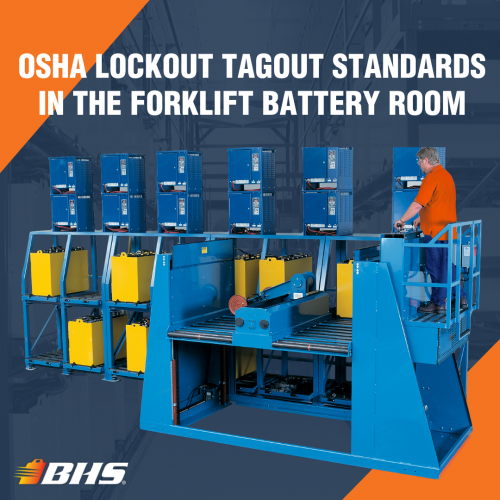We use cookies to make your experience better. To comply with the new e-Privacy directive, we need to ask for your consent to set the cookies. Learn more.
OSHA Lockout Tagout Standards in the Forklift Battery Room

OSHA lockout tagout standards are crucial protections for workers who use heavy machinery. According to one OSHA fact sheet, compliance with federal safety rules on “control of hazardous energy” stop 50,000 injuries from taking place every year. Even more importantly, they save an estimated 10 lives per month.
Forklift battery rooms are a prime example of areas where lockout/tagout procedures keep workers safe. Charging and changing forklift batteries requires heavy machinery, incredible hydraulic power, and lots of electricity. Without a foolproof system for informing maintenance and service staff when machinery is powered, it’s difficult to work safely on and around these machines.
So let’s take a look at what OSHA has to say about employer responsibilites surrounding lockout/tagout procedures. Then we’ll apply these rules to the unique environment of the forklift battery room.
OSHA Lockout Tagout Standards According to the Code
The relavent part of the Code of Federal Regulations here is standard 1910.147 — The control of hazardous energy (lockout/tagout). This unwieldy name belies a fairly simple command, issued in regulation 1910.147(c)(1):
- Energy control program. The employer shall establish a program consisting of energy control procedures, employee training, and periodic inspections to ensure that before any employee performs any servicing or maintenance on a machine or equipment where the unexpected energizing, startup, or release of stored energy could occur and cause injury, the machine or equipment shall be isolated from the energy source and rendered inoperative.
The method by which we accomplish these goals is the lockout and/or tagout system. A lockout device is often actually a keyed padlock; it must hold an energy isolating device in a position that prevents equipment from becoming energized. It must also give one or more particular employees sole power over repowering the machinery.
The energy isolating device will vary from one piece of equipment to another, but generally, it may be a circuit breaker or electrical disconnection switch, or another means of cutting off all possibility of power from the machine. In cases of mechanical energy, the isolating device might be a line valve or even a block.
For Operator Aboard Battery Extractor Systems, the onboard Electrical Distribution System includes dedicated Circuit Breaker Units. These function as energy isolating devices throughout the system.
A tagout device, on the other hand, is simply a warning sign. Typically, it’s a paper tag with a string that allows it to fasten to the energy isolating device. The crucial difference here is that a lockout device physically prevents users from activating the energy isolating device. A tagout device simply warns that the energy isolated device should not be touched until the original placer of the tag removes it, signifying safety.
Supplementing Lockout/Tagout Systems in the Battery Room
In addition to lockout and tagout devices on circuit breakers in an Operator Aboard Battery Extractor System, cloud-based solutions associated with the Industrial Internet of Things can control who has access to the system, and when. A touchscreen log-in panel can prevent users from powering on the equipment during pre-programmed times. It can also require operators to go through certain safety steps — running the daily checklist, for instance, or verifying that there’s no scheduled maintenance or other work in the battery room that shift — before they can use the Battery Extractor.
In combination with the energy isolating devices provided by a BHS Electrical Distribution System, OSHA-compliant lockout and tagout devices, and a great training program, digital log-in panels on Operator Aboard Battery Extractors create the safest battery room possible — as well as compliance with OSHA lockout tagout standards.
References:
“OSHA Fact Sheet: Lockout/Tagout.” OSHA. U.S. Occupational Safety and Health Administration, 2002. PDF. 12 Nov. 2019.
“CFR 1910.147: The control of hazardous energy (lockout/tagout).” OSHA. U.S. Occupational Safety and Health Administration, n.d. Web. 12 Nov. 2019.
